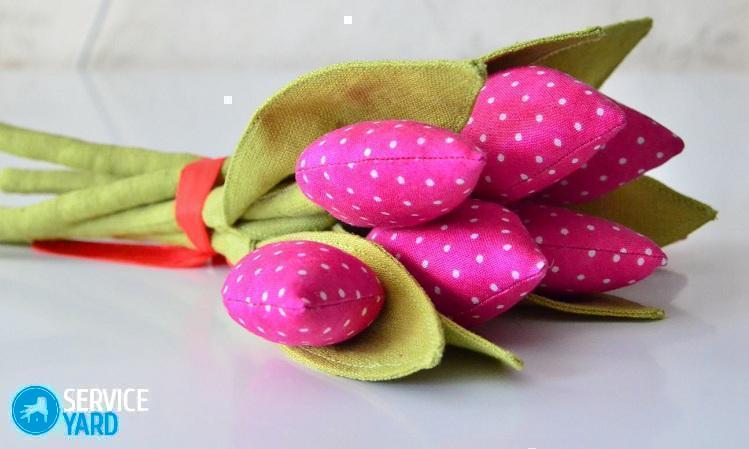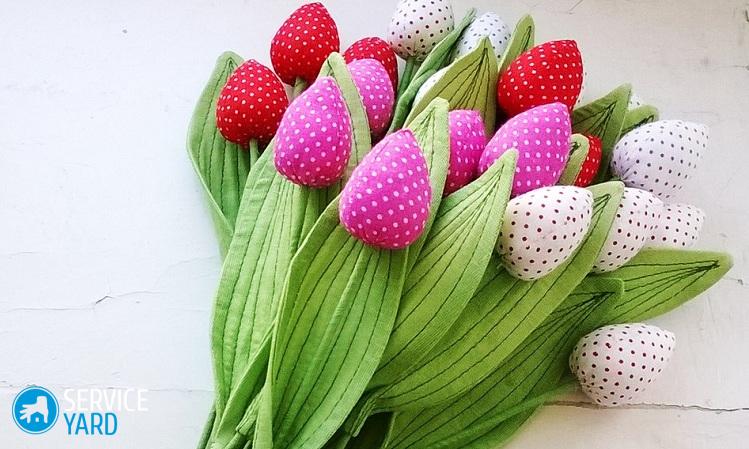How to sew tulips from fabric with your own hands?

Fabric tulips today have won the hearts of many people. In addition to the fact that they look very interesting in any interior, they are also a great gift. To create such a “masterpiece”, you do not need much time and financial costs, and we will tell you how to sew a tulip from a fabric with your own hands. All the proposed methods are not laborious and require a little physical effort. As a result, you will receive beautiful flowers in a matter of minutes that will delight you and cheer you up at any time of the year.
to contents ↑Important! Bouquets look very advantageous in which several types of fabric tulips are combined at once. The most important thing is to show creative imagination.
Method number 1
These tulips are very delicate and it is best to take cotton as the basis for their manufacture.
Important! This bouquet will be the perfect decoration for the spring-summer season.
You will need the following materials and tools:
- Cotton (flax or other natural fabrics can be used);
- Threads in color;
- Needles;
- Scissors;
- Sewing machine;
- Filler (synthetic winterizer possible);
- Crepe - green paper;
- Wire;
- Hot melt adhesive.
The sequence of actions to sew tulips from a fabric with your own hands is as follows:
- Cut a strip of fabric measuring 11x15 centimeters. Fold the long side inwards by 1 centimeter.
- Fold the blank face inward. Stitch side edges.
- Manually near the bent edge, make a dashed seam. Tighten and tighten the threads.
- Turn the finished workpiece to the front side. Raw edges should be bent inwards.
- Fill the future flower bud with filler.
- Grab a thread in the middle of the two upper parts of the workpiece.
- Perform the same operation with other parties. Fasten everything with a neat seam. That's all, the bud is ready. Next, you can proceed to the manufacture of the stem.
Important! To make the bud look even more tender and interesting, you can decorate its middle, for example, sew a bead, butterfly or bee. <
- Take the wire and twist it with crepe paper.
- Attach the finished stem using hot-melt adhesive to the bud.
Your fabric tulip is ready! It will take you about 10 minutes to make it. And in an hour you can make a beautiful bouquet of spring flowers.
to contents ↑Method number 2
In order to make a tulip from a cloth with your own hands, you will need:
- Wooden skewers or thick wire;
- Floral tape;
- Scissors;
- Synthetic winterizer;
- A flap of pink fabric for a bud;
Important! You can safely experiment and choose absolutely any color for your future flower, even the most unusual.
- Flap of green fabric for leaves.
If all the materials are prepared, you can begin to work:
- The first step is to build a pattern. For each flower you will need three petals for the bud and 2 leaves.
- Fold the pink cloth three times. Attach the finished template to it and transfer the pattern to the fabric. Cut out future petals.
Important! For greater convenience, the fabric can be secured with sewing pins during the process of transferring the pattern and cutting.
- The green fabric must be folded in half. Similarly, like the petals, cut out the leaves.
Important! If you want to make a whole bunch of flowers, you can make several patterns at once.
- Sew the leaves around the edge. Turn them on the front side and iron them well.
- Take 2 petals and sew them along one side.
- Attach the third petal to the first two.
- Turn the finished stock of the bud on the front side.
- Fill it with a padding polyester.
Important! In order for your tulip to exhale the smell of flowers, you can drop a few drops of perfume or other fragrance into the filler.
- To make the stem, you need to tightly wrap the skewer along the entire length with a floral tape. One end should be left free.
- Take your bud blank. Sew the non-stitched side with a sewn seam. Tighten a little.
- Insert the skewer into the hole and tighten the thread tightly.
Important! To fix it firmly, glue should be applied to the edge of the skewer.
- Wrap the tip of the leaf around the stem. Secure with thread.
That's all, your tulip is ready! Make a few more or simply decorate with ribbon. In any case, this gift will be the most extraordinary at the holiday.
to contents ↑Method number 3
We bring to your attention another version of a rather unusual and interesting flower. In order to sew a tulip from a fabric with your own hands in this way, you will need:
- Colored fabric for the bud;
- Green tissue flap;
- Threads in color;
- Needles;
- Sewing machine;
- Glue;
- Wooden skewer;
- Synthetic winterizer;
- Bead.
So, let's get to work. The sequence of actions is as follows:
- From a colored fabric, cut two squares of the same size.
- In one of the squares in the middle, cut a circle to make a hole.
- Sew the squares together and twist to the front.
- Fill the blank with padding polyester.
- Sew the hole inside the square around the circumference and tighten it tightly.
- We make a stalk. To do this, cut strips of equal skewer length and a width of about 1 centimeter from green cloth. Put glue on them, put the skewer inside and wrap it. Wait for a while until the glue sets.
- Apply glue to the end of the skewer and attach it to the bud.
- Similarly, as in the previous method, leaflets are cut out and stitched.
Important! If desired, the leaves can also be filled with a small layer of padding polyester.
- Fasten them with glue to the stalk.
- Sew a bead in the middle of the bud.
Method number 4
We offer you to sew Tilda tulips, which are so popular today among needlewomen. To make them you will need:
- Colored fabric for buds;
Important! The color of the future bud depends entirely on your taste preferences. But it is best to choose pink, yellow and white tones for such a flower.
- Green fabric for stems;
- Needle;
- Threads in color;
- Scissors;
- Material for stuffing, for example, synthetic winterizer or holofiber;
- Sewing machine.
Important! Try not to purchase knitted fabrics. Pay attention to fleece, satin or satin. They look most advantageous in this type of fabric tulips.
Let's get to work:
- Draw patterns on thick paper.
- Transfer the pattern to the fabric. For one tulip, you will need 2 teardrop-shaped details for the bud and leaf, 2 strips for the stem.
- Next - take the elements of your stalk and sew, leaving one side unbroken. Do the same with other blanks except leaflets. We flash them completely.
Important! When stapling, be sure to make allowances so that your tulip does not fall apart later.
- If desired, stitch the leaves around the perimeter with a sewing machine, so that the effect of streaks is obtained.
- Turn all the details of the flower to the front side.
- Fill the bud tightly with the filler.
- Fold the bottom edge of the bud, sew it around the circumference. Pull the thread.
- Insert the stem into the remaining hole, fix it and pull it with the thread until it stops. Lock her.
- Wrap a leaflet around the stalk and sew it.
That's all, your Tilda tulip is ready!
to contents ↑Important! In a single copy, it is better not to give it. Such flowers look most advantageous in a beautifully designed bouquet with the number of tulips 7-9 pieces.
Stock footage
Fabric tulips are very delicate and original analogues to fresh flowers, but unlike them, such products do not require care and will last you much longer.In addition, the creation of fabric tulips will cheer you up, and the finished result will only please you. Using the above workshops, you will create flowers that will bring a warm spring atmosphere into your home, even if a winter blizzard rages outside.
- How to choose a vacuum cleaner taking into account the characteristics of the house and coatings?
- What to look for when choosing a water delivery
- How to quickly create comfort at home - tips for housewives
- How to choose the perfect TV - useful tips
- What to look for when choosing blinds
- What should be running shoes?
- What useful things can you buy in a hardware store
- Iphone 11 pro max review
- Than iPhone is better than Android smartphones






